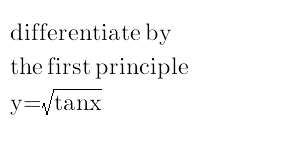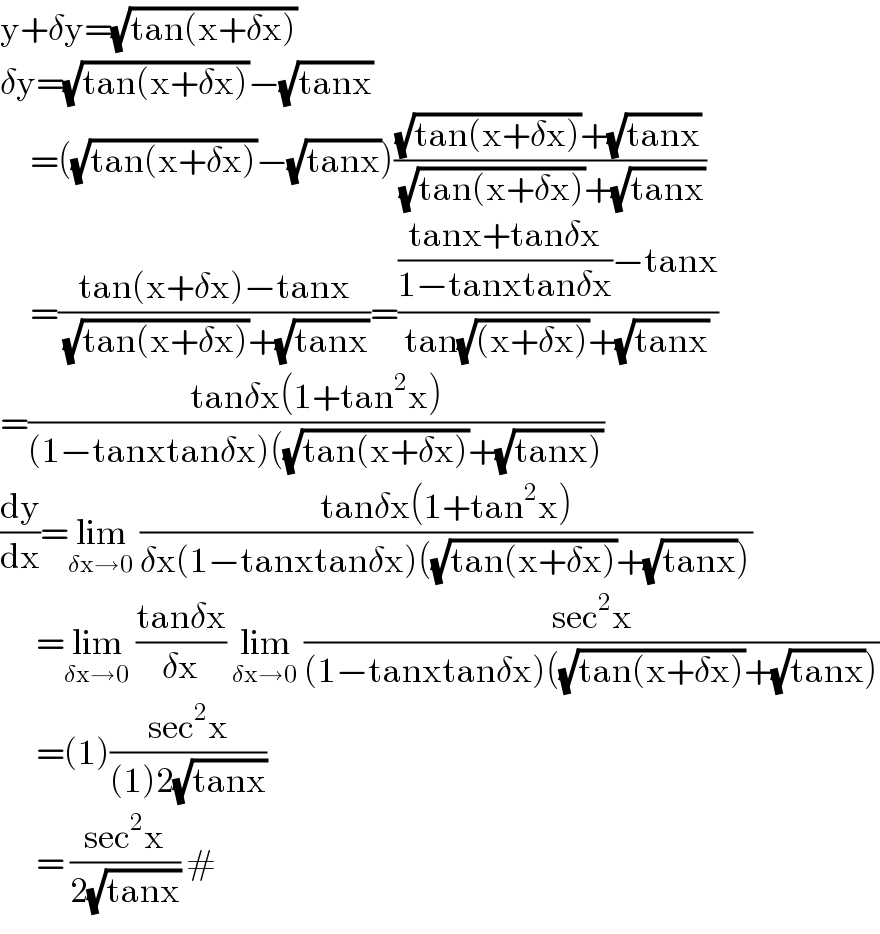
Question and Answers Forum
Question Number 21464 by mondodotto@gmail.com last updated on 24/Sep/17

Answered by myintkhaing last updated on 24/Sep/17

Answered by $@ty@m last updated on 24/Sep/17
![(dy/dx)=lim_(δx→0) (((√(tan (x+δx)))−(√(tanx )))/(δx)) (dy/dx)=lim_(δx→0) (((√(tan (x+δx)))−(√(tanx )))/(tan(x+δx)−tan x))×((tan(x+δx)−tan x)/(δx)) =L_1 ×L_2 where L_1 =lim_(δx→0) (((√(tan (x+δx)))−(√(tanx )))/(tan(x+δx)−tan x)) =(1/(2(√(tan x)))) , using formula lim_(x→a) ((x^n −a^n )/(x−a))=na^(n−1p) and L_2 =lim_(δx→0) ((tan(x+δx)−tan x)/(δx)) =lim_(δx→0) (1/(δx))[((sin (x+δx))/(cos (x+δx)))−((sin x)/(cos x))] =.... =... =sec^2 x {Do it yourself} ∴(dy/dx)=((sec^2 x)/(2(√(tanx ))))](Q21479.png)
| ||
Question and Answers Forum | ||
Question Number 21464 by mondodotto@gmail.com last updated on 24/Sep/17 | ||
 | ||
Answered by myintkhaing last updated on 24/Sep/17 | ||
 | ||
| ||
Answered by $@ty@m last updated on 24/Sep/17 | ||
![(dy/dx)=lim_(δx→0) (((√(tan (x+δx)))−(√(tanx )))/(δx)) (dy/dx)=lim_(δx→0) (((√(tan (x+δx)))−(√(tanx )))/(tan(x+δx)−tan x))×((tan(x+δx)−tan x)/(δx)) =L_1 ×L_2 where L_1 =lim_(δx→0) (((√(tan (x+δx)))−(√(tanx )))/(tan(x+δx)−tan x)) =(1/(2(√(tan x)))) , using formula lim_(x→a) ((x^n −a^n )/(x−a))=na^(n−1p) and L_2 =lim_(δx→0) ((tan(x+δx)−tan x)/(δx)) =lim_(δx→0) (1/(δx))[((sin (x+δx))/(cos (x+δx)))−((sin x)/(cos x))] =.... =... =sec^2 x {Do it yourself} ∴(dy/dx)=((sec^2 x)/(2(√(tanx ))))](Q21479.png) | ||
| ||